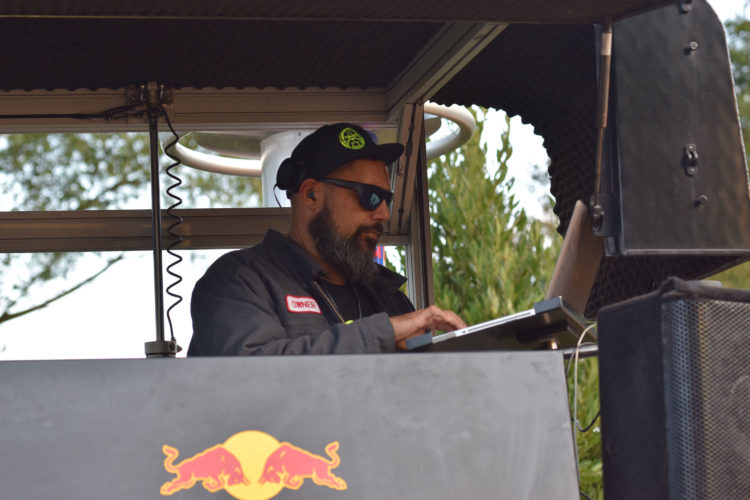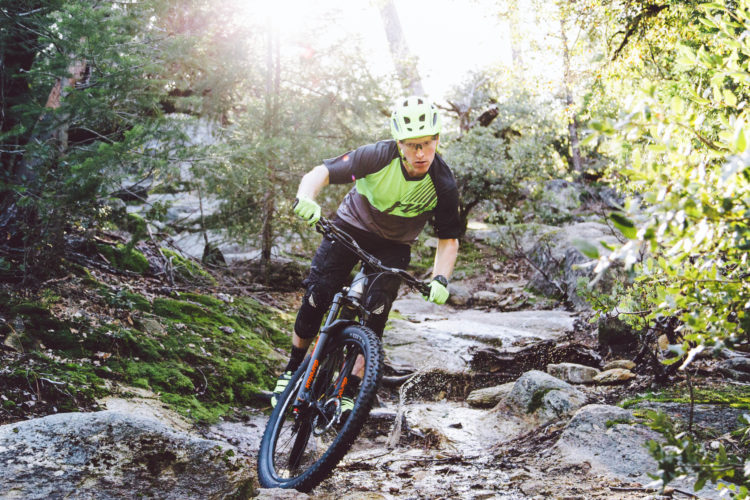
The rock face seemed to grow as a I looked down from above. Ten feet. Twenty feet. Thirty feet, like some Alice in Wonderland phenomena but in reverse. I wasn’t growing at all. My buddy had just dropped, skittering down the granite wall with ease. I had actually ridden this feature before. Last year, when the trail opened, I rode it two or three times before I got a little cocky and rammed my front wheel into the front edge of a rock and somersaulted over the bike, using my MIPS to its intent.
A year later, with less time in the bike park, less time on unfamiliar trails, and less time sharpening my metaphorical blade on whetstones, I was stuck. To complete the line required not only a commitment to ride where brakes aren’t useful anymore but an unnerving and awkward entry as well. A lot of riders don’t even see the feature and focus on what’s around the switchback, directly in front of them. You kind of have to be looking for trouble to spot this wall.
By riding past the switchback, and making a Y, instead of following the U, there’s a rise, and the rider needs to unweight the front wheel before pushing it back down. Then they must center themselves again on the bike, modulate the brakes over the loose granite wall, before the next, steeper granite wall. Before they’re on the wall for long, they need to turn the bars right to exit correctly, keep off the brakes until it “flattens” out onto the still steep trail, and then dodge rocks and stay between the borders of the singletrack. It sounds like a lot and it is, but it’s quite a cool move.
I sat up there for a minute or two, playing it out in my head, moving my hands and hips in a way that would coordinate with the line, like a shadow boxer, and grabbed my bike. I rode up to the wall, just over the awkward entry, unclipped and looked over.
“Ok. Let me try again,” I told my buddy as he stood below with his phone pointed at the wall.
The same thing happened though. And again. On the last run up, I looked over again and no matter how I played the scenario in my head, it felt like I couldn’t do it. “I don’t think I’m feeling it today.”
“No problem,” he said and we shot back down the trail. I didn’t roll the wall that day and I didn’t feel bad about it. We’ve all been there before, looking at a jump, a wall, a drop, or a fall line that one of our friends just cleaned, eager to ride it and then deciding against it.
Every time feels the same. For a feature I know I can ride, the longer I look at it, the bigger it gets. Like a video game villain, with each minute of hesitation the dragon swells with size and fury. For each minute we analyze the line, try to calculate the size of the jump and the speed and amplitude we need, it gets more difficult to pull the trigger.
There must be some science to this, my psych-nerd side told me. Without hesitation, I punched my question into Google, hoping for an answer. Thumbing down the results list, none of the articles looked promising.
‘How to Conquer Analysis Paralysis.’
‘The Psychology of Indecision.’
‘The Science of Analysis Paralysis.’
Like too many pieces of content online, there are a lot of catchy titles, and not a lot of answers. To be fair, like anything in psychology there are a multitude of answers that one’s indecisiveness can be pointed at.
The most credible and informative piece I found is on Psychology Today. However, there still aren’t any answers, just suggestions to help move past the trap: Be aware of AP, is the problem that significant?, you might be a perfectionist, try to make decisions more quickly, practice assertiveness, and don’t be a perfectionist. Right.
The most salient answer I found, was that AP may be caused by anxiety. “Yes!” I thought. I do feel a little anxious when I’m looking at a fall line that my friend just thundered through, and question if I can do the same. But, don’t we all?
A week or two later I went back to the same trail with my same friend, and we stopped at the same feature. Once again, he hopped into the fall, skittered down the wall, and rode away with confidence. “You gonna try it?” he asked.
“Yeah, I’ll go for it today.” I rode up and over the entry-hump, kept the brakes on and rolled into the wall more slowly than I had a year ago, spotted my exit, ripped out, and reeled myself back into the center of the trail. Whew. “Man, that felt good!”
I hoped there was something I could point to when it came to analysis paralysis. Something to put a name on, and attribute my indecision to, because shouting out, “I would love to hit this jump today, but I can’t. My analysis paralysis is kicking in,” doesn’t cut it.
There isn’t though. Once again, I am thinking into it too much. Sometimes you feel like it and sometimes you don’t.





















9 Comments
Dec 3, 2020
But, IMO it really comes down to risk vs reward and not analysis paralysis. From reading your note, you KNEW where the lines were and what was needed to successfully ride it, i.e. analysis complete! But, after your endo your confidence was shaken... totally understandable. It's one thing to take some time to figure out what line you want to take before hitting something, but it's entirely something else when you are not (sufficiently) confident you can ride something. When that much doubt creeps in we all need to do what you did... skip it... at least for that time. The feature will still be there next time when you will hopefully be in a more confident mindset as you were on the return. Keep shreddin'!
Dec 3, 2020
Dec 3, 2020
Those who routinely tell themselves, "Don't think, just do it" often have the broken bones to show for it. Yet the other extreme -- passing unless you're absolutely sure you can do something -- isn't very satisfying either. The middle is uncomfortable, but IMO it's better than either extreme.
Dec 3, 2020
Dec 3, 2020
Admittedly this is only the end of my first season of riding, but I've found this and my "gut" to be a good tool for avoiding disaster. If I'm feeling it and I can picture myself doing it, even if it's at the edge of my limits, I'll go for it. If I'm not feeling it or I keep picturing what could go wrong, I'll skip it even if it's well within my limits and I've done it before.
Fingers crossed, but this has helped me avoid any major catastrophes so far!
Dec 3, 2020
Dec 3, 2020
Dec 6, 2020
Dec 7, 2020